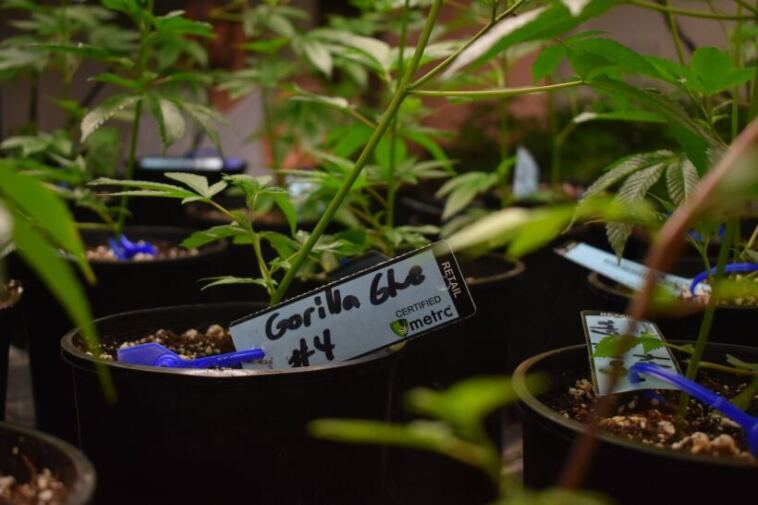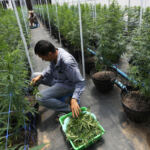- Like
- SHARE
- Digg
- Del
- Tumblr
- VKontakte
- Flattr
- Buffer
- Love This
- Save
- Odnoklassniki
- Meneame
- Blogger
- Amazon
- Yahoo Mail
- Gmail
- AOL
- Newsvine
- HackerNews
- Evernote
- MySpace
- Mail.ru
- Viadeo
- Line
- Comments
- Yummly
- SMS
- Viber
- Telegram
- JOIN
- Skype
- Facebook Messenger
- Kakao
- LiveJournal
- Yammer
- Edgar
- Fintel
- Mix
- Instapaper
- Copy Link
Introduction
Ever wondered how to grow cannabis seeds for the best results? Look no further! Whether you’re deciding between indica or sativa, pondering on seed types, or curious about the ideal climate – we’ve got you covered.
From the initial germination to the exciting harvest, this guide will provide straightforward steps and essential tips. Discover the optimal light cycle, watering techniques, and even ways to boost yields. And, when it’s all said and done, learn the art of drying and curing your prized buds.
Starting with the basics, understanding the type of cannabis seed you want to grow is crucial. Let’s get growing!
Should You Grow Indica or Sativa Cannabis Seeds?
Indica and sativa strains each have their unique growth patterns and effects. Indica strains typically grow shorter and bushier, making them ideal for indoor setups. On the other hand, sativa strains can grow tall, often requiring more vertical space.
It is best to decide which type of cannabis strain to grow based on your growing environment and what kinds of effects you want from your weed.
Indica effects
- Physical Effects: Indica strains are often said to produce a “body high.” This means they can be physically sedating and relaxing, making them preferable for nighttime use.
- Therapeutic Benefits: Indicas are frequently sought out for pain relief, muscle relaxation, and to help with sleep. They can also reduce nausea, increase appetite, and combat insomnia.
- Mental Effects: Indica strains might make you feel relaxed, calm, and even a bit introspective or spacey.
Sativa effects
- Physical Effects: Sativas tend to produce a more energetic and uplifting “head high.” This can make them ideal for daytime use or when you need to remain active.
- Therapeutic Benefits: These strains are often preferred for their anxiety-reducing effects, anti-depressant qualities, and ability to promote focus and creativity.
- Mental Effects: Sativa strains are known for inducing feelings of optimism, well-being, and increased energy. They can stimulate thought, conversation, and creativity.
Feminized, Regular, or Autoflowering Seeds?
For beginners, feminized seeds are popular due to their guaranteed female plants, eliminating the guesswork. Regular seeds can be male or female, so growers need to spot and remove male plants to prevent pollination. Autoflowering seeds offer a quick harvest cycle, not relying on light changes to flower, which can be ideal for those seeking speed.
Where is the Best Place to Buy Cannabis Seeds?
For trusted seed sources, consider ILGM (I Love Growing Marijuana) and MSNL (Marijuana Seeds NL). Both have established reputations for quality and a broad variety of strains. Always prioritize quality over quantity when investing in seeds to ensure a rewarding growth experience.
What is the Ideal Climate for Growing Cannabis?
Cannabis thrives in a climate similar to its native habitat. Ideal temperatures range between 68°F to 77°F (20°C to 25°C) during the day. Adequate humidity is also essential, with younger plants preferring higher levels (60-70%) which should be gradually reduced to around 40-50% as they mature to avoid mold growth.
What is the Best Way to Germinate Cannabis Seeds?
The paper towel method is a favorite among growers. Simply place your seeds between two moistened paper towels, then place them inside a zip-lock bag or between two plates. Store them in a warm, dark place. Check daily to ensure the paper towels remain moist, and to check for sprouting.
How Long Do Cannabis Seeds Take to Root?
After germination using the paper towel method, seeds usually start to show roots in 24 to 48 hours. Once you see a small white root, it’s time to transplant the seedling into its growing medium.
How Long Does it Take from Seed to Buds?
The timeframe from seed to bud varies by strain and growing conditions. On average, indoor growers can expect about 3-4 weeks of vegetative growth. Flowering can last 7-12 weeks depending on the strain. Thus, the entire process might take anywhere from 10 to 16 weeks, though some strains and growth conditions can extend this timeframe.
How Do You Water Cannabis Plants?
Watering cannabis plants requires a keen eye. Over-watering and under-watering can both harm your plants. It’s best to water when the top 1-2 inches of the soil feels dry to the touch. Ensure your pots have proper drainage to prevent stagnant water and root rot. Remember, it’s always better to start with less and add more as the plants demand.
What Nutrients Do Cannabis Plants Need?
Cannabis requires a balance of both macro and micronutrients:
- Macro Nutrients: These are the primary nutrients cannabis needs in larger amounts.
- N (Nitrogen): Essential during the vegetative stage, it promotes healthy, vigorous growth.
- P (Phosphorus): Key during the flowering stage, it aids in bud development.
- K (Potassium): Important for the overall health of the plant, supporting photosynthesis, water uptake, and enzyme activation.
- Micro Nutrients: Required in smaller amounts, they include calcium, magnesium, sulfur, boron, copper, iron, manganese, molybdenum, and zinc. These help in various cellular activities and enzyme functions.
During the vegetative stage, a higher nitrogen mix (like a 3-1-2 NPK ratio) is ideal. As you transition to the flowering stage, phosphorus and potassium become more crucial (like a 1-3-2 NPK ratio).
What Light Cycle Is Best for Cannabis?
- Autoflowering Strains: Unlike photoperiod strains, autoflowers don’t rely on light cycles to determine their growth stages. Most growers keep them on a 20/4 or 18/6 light/dark schedule for their entire life cycle.
- Photoperiod Strains (Veg Stage): Typically kept on an 18/6 light/dark cycle to promote growth.
- Photoperiod Strains (Flowering Stage): Switch to a 12/12 light/dark cycle to induce flowering.
How to Train Your Cannabis Plant for Bigger Yields?
LST (Low Stress Training)
Basics and Aim: LST is a method used to manipulate the shape of the cannabis plant. The primary goal is to make it more bushy than tall, ensuring an even canopy. By doing so, light penetration improves, ensuring all parts of the plant receive adequate light, which can increase yield.
How It’s Done:
- Use soft garden ties or gentle wire to bend branches horizontally, making them grow more outward than upward.
- Secure the bent branches in place without causing any damage.
- Adjust and reposition ties as the plant grows to maintain the desired shape.
HST (High Stress Training)
Basics and Aim: HST techniques cause deliberate damage to the plant (in a controlled manner) to enhance its growth and yield. While more aggressive than LST, these techniques aim to increase the number of bud sites or create a more even canopy.
Topping:
-
- Basics: This method involves cutting the top of the main stem to stop its growth, encouraging the plant to grow two main stems instead of one. Topping autoflowering plants can be risky because of their shorter life cycle so tread carefully if you decide to top your autos.
- How It’s Done: Once the plant has at least 3-4 nodes, use sterilized scissors to cut the newest node off the top. This causes the plant to direct its growth energy to the lower branches, making them grow thicker and stronger.
Fimming:
-
- Basics: Similar to topping, fimming aims to promote the growth of 3-4 main stems instead of one. The name originates from the acronym “FIM” or “F*** I Missed”, highlighting the less precise nature of the cut compared to topping.
- How It’s Done: Instead of making a clean cut like topping, you pinch or cut the newest growth, leaving some parts behind. This causes the plant to grow more tops, leading to a bushier plant.
Scrog (Screen of Green):
-
- Basics: The SCROG method involves using a screen to train the cannabis plant during its growth. This screen helps to spread out the plant’s branches, ensuring that all parts of the plant receive equal light.
- How It’s Done: Set up a screen or net 20-25 inches above your growing medium. As the plant grows, weave the branches into the screen. This not only supports the branches but also ensures that they grow in a flat, even layer. As flowering begins, the buds grow upwards through the screen, receiving ample light and airflow.
Training techniques can be combined, but always consider the plant’s health and your comfort level when implementing these methods.
Potential Problems to Look Out for When Growing Cannabis Seeds
- Bud Rot: A fungal disease affecting the buds. Look for browning, mushy buds with a moldy smell.
- Pests: Common pests include spider mites, aphids, and whiteflies. They can damage the plant and leave tiny webs or visible insects.
- Nutrient Burn: Yellow, brown, or burnt tips on the leaves indicate an excess of nutrients.
- Light Burn: If leaves nearest the light turn yellow or white, they might be getting too much light.
- Over-Watering: Leaves become droopy, and the soil stays wet for extended periods.
- Under-Watering: Dry soil and limp, lifeless leaves are indicative of this issue.
How to Harvest and Trim Your Bud
- When to Harvest: The best indicator is the color of the trichomes, tiny glandular hairs on the buds. Use a magnifier. When half of these trichomes turn milky white with some turning amber, it’s usually the right time.
- Cutting Down: Begin by cutting the main branches. Work in sections, starting from the bottom, moving upward.
- Trimming: Using sharp scissors, remove large fan leaves first, then trim away smaller sugar leaves that stick out from the buds. The goal is to retain as much of the resin-rich parts while removing excess plant material.
How to Dry and Cure Your Bud
- Drying: Hang the trimmed buds upside down in a room with consistent temperature (around 70°F or 21°C) and 50% humidity. Ensure good air circulation without direct air blowing onto the buds. This process typically takes 7-14 days.
- Curing: Place the dried buds in quart-sized mason jars, filling them ¾ full. Seal the jars and store them in a cool, dark place. For the first week, open the jars daily to let them breathe for about 15 minutes, which helps release any moisture and prevents mold growth. After this week, reduce airing out to once every few days. Proper curing can take 4-8 weeks, although longer curing can further improve flavor.
What Are the Best Strains to Grow?
- Space Runtz: Known for its euphoric effects and fruity flavor profile, Space Runtz is a balanced hybrid that combines the best of both indica and sativa traits.
- White Cherry Runtz: This strain stands out with its rich cherry flavor. It’s a potent hybrid offering a balanced high and a delightful aroma.
Both strains are notable for their terpene-rich profiles and excellent growth characteristics, making them ideal choices for both novice and experienced growers.


